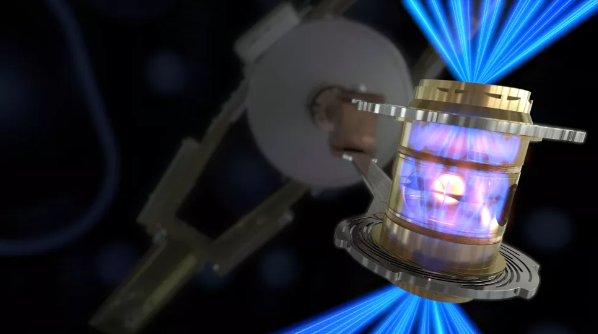By: Tereza Pultarova
View the original article here
A nuclear fusion experiment produced more energy than it consumed.

American researchers have achieved a major breakthrough paving the way toward nuclear fusion based energy generation, but major hurdles remain.
Nuclear fusion is an energy-generating reaction that fuses simple atomic nuclei into more complex ones, such as combining atoms of hydrogen into helium. Nuclear fusion takes place in the cores of stars when vast amounts of molecular dust collapse under gravity and create immense amounts of pressure and heat in the nascent stars’ cores.
For decades, scientists have therefore been chasing nuclear fusion as a holy grail of sustainable energy generation, but have fallen short of achieving it. However, a team from the Lawrence Livermore National Laboratory (LLNL) in California may have finally made a major leap to creating energy-giving ‘stars’ inside reactors here on Earth.
A team from LLNL has reportedly managed to achieve fusion ignition at the National Ignition Facility (NIF), according to a statement published Tuesday (Dec. 13). “On Dec. 5, a team at LLNL’s National Ignition Facility (NIF) conducted the first controlled fusion experiment in history to reach this milestone, also known as scientific energy breakeven, meaning it produced more energy from fusion than the laser energy used to drive it,” the statement reads.
The experiment involved bombarding a pencil-eraser-sized pellet of fuel with 192 lasers, causing the pellet to then release more energy than the lasers blasted it with. “LLNL’s experiment surpassed the fusion threshold by delivering 2.05 megajoules (MJ) of energy to the target, resulting in 3.15 MJ of fusion energy output, demonstrating for the first time a most fundamental science basis for inertial fusion energy (IFE),” LLNL’s statement reads.
Still, that doesn’t mean that fusion power is within grasp, LLNL cautions. “Many advanced science and technology developments are still needed to achieve simple, affordable IFE to power homes and businesses, and [the U.S. Department of Energy] is currently restarting a broad-based, coordinated IFE program in the United States. Combined with private-sector investment, there is a lot of momentum to drive rapid progress toward fusion commercialization,” the statement continues.
Even though this is only a preliminary step towards harnessing fusion power for clean energy, LLNL leaders are hailing the accomplishment as a transformative breakthrough. “Ignition is a first step, a truly monumental one that sets the stage for a transformational decade in high-energy density science and fusion research and I cannot wait to see where it takes us,” said LLNL Director Dr. Kim Budil during Tuesday’s press conference.
“The science and technology challenges on the path to fusion energy are daunting. But making the seemingly impossible possible is when we’re at our very best,” Budil added.”
Such conditions lead up to the ignition of the fusion reaction, which, however, in the current experiment was sustained for only a very short period of time. During the experiment, the energy generated by the fusing atoms surpassed the amount of energy required by the lasers igniting the reaction, a milestone known as net energy gain.
Scientists at the laboratory have conducted several fusion experiments in recent years, which haven’t generated the amount of power needed to claim a major breakthrough. In 2014, the team produced about as much energy as a 60-watt light bulb consumes in five minutes. Last year, they managed to reach a power output of 10 quadrillion watts of power — which was about 70% as much energy as consumed by the experiment.
The fact that the latest experiment produced a little more energy than it consumed means that for a brief moment, the reaction must have been able to sustain itself, using its own energy to fuse further hydrogen atoms instead of relying on the heat from the lasers.
However, the experiment only produced 0.4MJ of net energy gain — or about as much is needed to boil a kettle of water, according to the Guardian.
The breakthrough comes as the world struggles with a global energy crisis caused by Russia’s war against Ukraine while also striving to find new ways to sustainably cover its energy needs without burning fossil fuels. Fusion energy is not only free from carbon emissions but also from potentially dangerous radioactive waste, which is a dreaded byproduct of nuclear fission.
The New York Times, however, cautions that while promising, the experiment is only the very first step in a still long journey toward the practical use of nuclear fusion. Lasers efficient enough to launch and sustain nuclear fusion on an industrial scale have not yet been developed, nor has the technology needed to convert the energy released by the reaction into electricity.
The National Ignition Facility, which primarily conducts experiments that enable nuclear weapons testing without actual nuclear explosions, used a fringe method for triggering the fusion reaction.
Most attempts at igniting nuclear fusion involve special reactors known as tokamaks, which are ring-shaped devices holding hydrogen gas. The hydrogen gas inside the tokamak is heated until its electrons split from the atomic nuclei, producing plasma.
The lasers heated up the cylinder to a temperature of about 5.4 million degrees Fahrenheit, which vaporized the cylinder, producing a burst of X-rays. These X-rays then heated up a small pellet of frozen deuterium and tritium, which are two isotopes of hydrogen. As the core of the pellet heated up, the hydrogen atoms fused into helium in the first glimmer of nuclear fusion.
